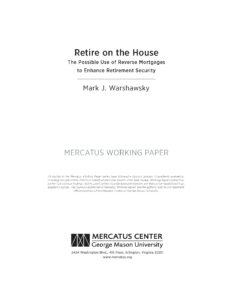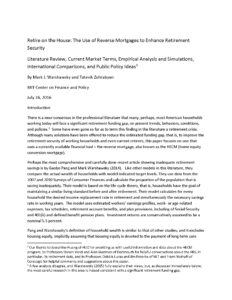This is a set of two papers by Mark J. Warshawsky on using reverse mortgages to enhance retirement security.
The first, is is based on a longer, similarly titled monograph by Mark J. Warshawsky and Tatevik Zohrabyan. That monograph, published in July 2016, was supported by the MIT Golub Center for Finance and Policy and was posted on that institution’s website. Sections are included in that monograph (but not in this paper) on market and policy developments for reverse mortgages in several other countries, and on details pertaining to the datasets used and to data and sample adjustments used in the empirical analysis here. Also, see a section in that monograph and in the paper by Warshawsky (2017) on a current comparison of market terms on immediate annuities and the payout from the HECM tenure product.
This paper focuses on the use of reverse mortgages or home equity conversion mortgages (HECMs) to enhance retirement security. If present trends continue, many American households working today will face a significant retirement funding gap, and this study asks whether reverse mortgages can be used to fill at least some of this estimated gap. This study provides a detailed description of the features and history of reverse mortgages; reviews the existing literature on the motivations people have to use their houses to pay for retirement expenses, especially for long-term services and supports; and, in original empirical simulations, finds that only 12–14 percent of all retired households are suitable for, and might sensibly use, home equity conversion mortgages. The paper concludes with some public policy ideas that would lower costs and increase demand for reverse mortgages, as well as encouraging their use in the United States to improve retirement security.
/wp-content/uploads/2019/05/warshawsky-reverse-mortgages-mercatus-v1.pdf
There is a near-consensus in the professional literature that many, perhaps, most American households working today will face a significant retirement funding gap, on present trends, behaviors, conditions, and policies.2 Some have even gone so far as to term this finding in the literature a retirement crisis. Although many solutions have been offered to reduce the estimated funding gap, that is, to improve the retirement security of working households and even current retirees, this paper focuses on one that uses a currently available financial tool – the reverse mortgage, also known as the HECM (home equity conversion mortgage).
Perhaps the most comprehensive and carefully done recent article showing inadequate retirement savings is by Gaobo Pang and Mark Warshawsky (2014). Like other models in this literature, they compare the actual wealth of households with model-indicated target levels. They use data from the 2007 and 2010 Surveys of Consumer Finances and calculate the proportion of the population that is saving inadequately. Their model is based on the life-cycle theory, that is, households have the goal of maintaining a similar living standard before and after retirement. Their model calculates for every household the desired income replacement rate in retirement and simultaneously the necessary savings rate in working years. The model uses estimated workers’ earnings profiles, work- or age-related expenses, tax schedules, retirement account benefits, and plan provisions, including of Social Security and 401(k) and defined benefit pension plans. Investment returns are conservatively assumed to be a nominal 5.5 percent.
/wp-content/uploads/2019/05/Warshawsky-Retire-on-the-House.pdf

